Realme is a company which has, since its introduction early this year, made a big impact in the budget segment with its smartphones Realme 1 and
**Realme 2** . It looked as though the budget smartphone king Xiaomi finally had a real and worthy competitor. Riding on the two devices’ success, Realme is now aiming for an even bigger market with its recently announced Realme 2 Pro. [caption id=“attachment_5355051” align=“alignnone” width=“923”] The Realme 2 Pro looks every bit as the Oppo F9 Pro from the front. Image: tech2/Kshitij Pujari[/caption] The first time I saw the
**Realme 2 Pro** , my thoughts were that this phone looks just like the
**Oppo F9 Pro** , but with a less flashy design. Though the Realme 2 Pro starts from Rs 13,990 for 4 GB RAM and 64 GB internal storage, the model I received was the very top-end one which costs Rs 17,990 and had 8 GB RAM and 128 GB storage. After having spent close to two weeks with the device I believe that for this price point one can easily spend Rs 2,000 more and get a
**Poco F1** . In my opinion, if people really want to buy the Realme 2 Pro, then the should definitely go with the Rs 13,990 model. Here’s why. Build and Design: 6/10 The Realme 2 Pro is an unusually thick phone at 8.5 mm or at least it feels quite thick in the hand. Comparing the thickness of the
**Mi A2** and Realme 2 Pro revealed that the latter looked nearly 30-40 percent thicker. It was also quite heavy in my hand which is quite surprising since the phone does not pack in a massive battery. [caption id=“attachment_5355081” align=“alignnone” width=“1280”]
The DewDrop notch on the phone gives it an impressive screen-to-body ratio. Image: tech2/Kshitij Pujari[/caption] On the front, we see the water drop notch which Realme is calling as the Dewdrop screen. The phone looks identical to the F9 Pro from the front and it is not surprising since Realme is an Oppo sub-brand at the end of the day. On the back, we see that Realme has abstained from the use of its diamondback design which we saw in both Realme 1 and Realme 2. Now we have a single shade polycarbonate back which looks a bit dull to me. The fingerprint scanner and dual-cameras are also present at the back. [caption id=“attachment_5355161” align=“alignnone” width=“1280”]
 The Realme 2 Pro is unusually thick. Image: tech2/Shomik Sen[/caption] On the bottom, we find a 3.5 mm headphone jack, a speaker grill, and a micro USB port. On the right side, we see the power button while on the left we see the dual-SIM trays and the volume rocker buttons. Overall, the phone feels a bit bulky and not quite ergonomic. Features: 7.5/10 The Realme 2 Pro has a 6.3-inch FHD+ IPS LCD panel having a 19.5:9 aspect ratio and a screen-to-body ratio of nearly 90 percent as per the company. Under the hood, the phone has a Qualcomm Snapdragon 660 chipset along with 8 GB of RAM and 128 GB of internal storage. As mentioned before, there are other storage variants as well. There is also the option of expanding your storage using a microSD card of up to 256 GB capacity. The phone has a fingerprint scanner at the back and runs on Android 8.1 Oreo out of the box with Oppo’s proprietary ColorOS 5.2 skin running on top. [caption id=“attachment_5355091” align=“alignnone” width=“1280”]
The Realme 2 Pro is unusually thick. Image: tech2/Shomik Sen[/caption] On the bottom, we find a 3.5 mm headphone jack, a speaker grill, and a micro USB port. On the right side, we see the power button while on the left we see the dual-SIM trays and the volume rocker buttons. Overall, the phone feels a bit bulky and not quite ergonomic. Features: 7.5/10 The Realme 2 Pro has a 6.3-inch FHD+ IPS LCD panel having a 19.5:9 aspect ratio and a screen-to-body ratio of nearly 90 percent as per the company. Under the hood, the phone has a Qualcomm Snapdragon 660 chipset along with 8 GB of RAM and 128 GB of internal storage. As mentioned before, there are other storage variants as well. There is also the option of expanding your storage using a microSD card of up to 256 GB capacity. The phone has a fingerprint scanner at the back and runs on Android 8.1 Oreo out of the box with Oppo’s proprietary ColorOS 5.2 skin running on top. [caption id=“attachment_5355091” align=“alignnone” width=“1280”] There is no diamond-like design on the Realme 2 Pro and instead, a single tone super reflective surface has been used. Image: tech2/Shomik Sen[/caption] In the camera department, we see that the phone has a 16 MP primary sensor along with a 2 MP secondary camera which acts as a depth sensor. On the front, we see a 16 MP camera with f/2.0 aperture. The phone can record 2160p@30fps, 1080p@30fps and does not support 4K recording. In terms of connectivity options, we see that the phone fulfils all the basic requirements such as dual 4G VoLTE SIM slots, Wi-Fi 802.11 а/b/g/n/ac, Bluetooth 5.0, GPS, 3.5 mm headphone jack, and a micro USB 2.0 OTG cable. Powering the device is a non-removable Li-Ion 3500 mAh battery. Display: 7.5/10 Right from the get go I’d like to say that I’m a big fan of this water drop style notch. If you don’t want to incorporate a mechanical slider like the
**Oppo Find X** or
**Vivo NEX** , it makes a lot of sense to go with this tiny little notch, which for the entirety of my usage has remained invisible to me. The shape of the notch is also an elegant curved V-shaped design and not the slight U-shaped notch we saw on the
**Vivo V11 Pro** . [caption id=“attachment_5355211” align=“alignnone” width=“1280”]
There is no diamond-like design on the Realme 2 Pro and instead, a single tone super reflective surface has been used. Image: tech2/Shomik Sen[/caption] In the camera department, we see that the phone has a 16 MP primary sensor along with a 2 MP secondary camera which acts as a depth sensor. On the front, we see a 16 MP camera with f/2.0 aperture. The phone can record 2160p@30fps, 1080p@30fps and does not support 4K recording. In terms of connectivity options, we see that the phone fulfils all the basic requirements such as dual 4G VoLTE SIM slots, Wi-Fi 802.11 а/b/g/n/ac, Bluetooth 5.0, GPS, 3.5 mm headphone jack, and a micro USB 2.0 OTG cable. Powering the device is a non-removable Li-Ion 3500 mAh battery. Display: 7.5/10 Right from the get go I’d like to say that I’m a big fan of this water drop style notch. If you don’t want to incorporate a mechanical slider like the
**Oppo Find X** or
**Vivo NEX** , it makes a lot of sense to go with this tiny little notch, which for the entirety of my usage has remained invisible to me. The shape of the notch is also an elegant curved V-shaped design and not the slight U-shaped notch we saw on the
**Vivo V11 Pro** . [caption id=“attachment_5355211” align=“alignnone” width=“1280”] The Realme 2 Pro has a great display with slightly muted colours. Image: tech2/Kshitij Pujari[/caption] That being said, the Realme 2 Pro does not seem to have the most colourful of displays. Sure it got bright enough in sunny conditions and also got considerably dim in the night, but I feel that the screen could have been more colourful. After playing the same video side by side on both the Mi A2 and the Realme 2 Pro, I have to say that the Mi A2 did have an edge over the Realme. By no accounts am I saying that the Realme 2 Pro has a bad display. As a matter of fact, it has one of the largest displays you can get in its price range on a body that’s about the size of a regular phablet. I’m just saying that the display could be more vibrant than it is now. In any case, a regular user will not be able to discern the difference unless it’s placed beside a phone with a better display. OS and Software: 6/10 In terms of the software, I fell that ColorOS falls short of expectations for a custom skin on Android. Although the phone comes with the Android 8.1 Oreo out of the box, the ColorOS 5.2 skin, for the most part, hinders usage. There are a few things I hate about it, with the most important being the lack of an app drawer. The settings menu was quite confusing and some of the actions such as finding out the amount of storage left on the phone were hidden extremely deep inside. [caption id=“attachment_5354751” align=“alignnone” width=“850”]
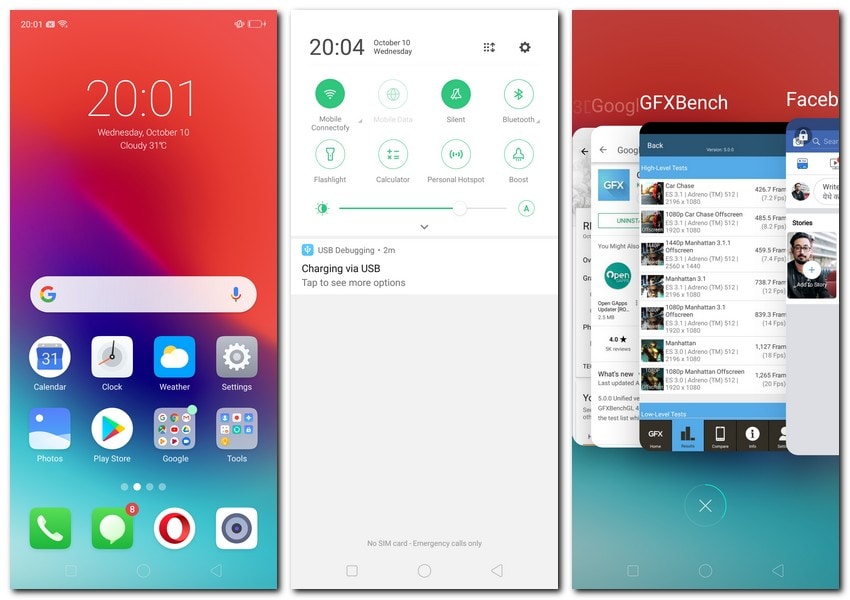 Realme 2 Pro UI.[/caption] There’s a lot of bloatware strewn across the interface such as something called the Realme Share and quite a few times I clicked on it thinking it’s a hotspot tethering option. There are also duplicate apps for Music, photos, gallery, browser and so on. Also, you cannot uninstall any of them. This is just a colossal waste of space and having alternative apps for popular functions is just not needed. I am not going to stop using ShareIt to use a custom Realme app for the same function. Packing a phone with custom apps which cannot be uninstalled, is not helping anyone. Individual notifications cannot be removed with a single swipe. First, you’ll have to swipe left on the notification and then a red dustbin icon appears which upon being clicked removes the notification — again, completely pointless. If it’s a clean software experience that you are after, then, in my opinion, the Mi A2 is the way to go. If the software is not an issue for you then ColorOS will not be bothering you. Performance: 7.5/10 While the Realme 2 Pro does pack in seriously good internals, I have to say that since the Xiaomi Poco F1 came out, all phones under Rs 30,000 started to look quite underpowered, to say the least. The Realme 2 Pro variant that I had for testing, packs in the Snapdragon 660 SoC which is quite a decent mid-range chipset. Though benchmarks are not quite the final indicator of phone’s performance, the benchmarks below show how much of a gap both devices have. That is evident as the Poco F1 houses the flagship Snapdragon 845 SoC. In real life, the Realme 2 Pro is quite fast for daily activities such as streaming videos, clicking photos, opening multiple apps, and so on. However, I feel that the 8 GB RAM on the device could be a bit of an overkill. There are barely any apps that need that kind of RAM capacity on a mid-range device. If you are not a power user, even 4 GB RAM is more than enough for your needs. Sure, you do get less storage space with the 4 GB RAM model, but you have a microSD card expansion slot which can be used to boost the storage to 256 GB. [caption id=“attachment_5355121” align=“alignnone” width=“1280”]
Realme 2 Pro UI.[/caption] There’s a lot of bloatware strewn across the interface such as something called the Realme Share and quite a few times I clicked on it thinking it’s a hotspot tethering option. There are also duplicate apps for Music, photos, gallery, browser and so on. Also, you cannot uninstall any of them. This is just a colossal waste of space and having alternative apps for popular functions is just not needed. I am not going to stop using ShareIt to use a custom Realme app for the same function. Packing a phone with custom apps which cannot be uninstalled, is not helping anyone. Individual notifications cannot be removed with a single swipe. First, you’ll have to swipe left on the notification and then a red dustbin icon appears which upon being clicked removes the notification — again, completely pointless. If it’s a clean software experience that you are after, then, in my opinion, the Mi A2 is the way to go. If the software is not an issue for you then ColorOS will not be bothering you. Performance: 7.5/10 While the Realme 2 Pro does pack in seriously good internals, I have to say that since the Xiaomi Poco F1 came out, all phones under Rs 30,000 started to look quite underpowered, to say the least. The Realme 2 Pro variant that I had for testing, packs in the Snapdragon 660 SoC which is quite a decent mid-range chipset. Though benchmarks are not quite the final indicator of phone’s performance, the benchmarks below show how much of a gap both devices have. That is evident as the Poco F1 houses the flagship Snapdragon 845 SoC. In real life, the Realme 2 Pro is quite fast for daily activities such as streaming videos, clicking photos, opening multiple apps, and so on. However, I feel that the 8 GB RAM on the device could be a bit of an overkill. There are barely any apps that need that kind of RAM capacity on a mid-range device. If you are not a power user, even 4 GB RAM is more than enough for your needs. Sure, you do get less storage space with the 4 GB RAM model, but you have a microSD card expansion slot which can be used to boost the storage to 256 GB. [caption id=“attachment_5355121” align=“alignnone” width=“1280”] Thank god for the headphone jack on the device. Image: tech2/Shomik Sen[/caption] In terms of gaming, the phone performs reasonably well. I played both PUBG and Asphalt 9 on the medium settings and they ran decent enough for me to game for long hours. The phone does allow me to opt for a gaming mode, which frees up some background processes to ensure smoother gameplay. I didn’t see much of difference in either case. If gaming is something you really want to focus on then the Poco F1 is the way to go. One thing that has impressed me quite a lot is the highly responsive screen unlock on the phone and the fingerprint sensor as well. It unlocks blazingly fast. The face unlock works well even in low light conditions, which is impressive. The phone thankfully has a headphone jack. In terms of the audio quality, I was pleasantly surprised that the phone gave good high-quality audio. Obviously, the HDAC support for high-quality audio helps. The speaker, on the other hand, seems obnoxiously loud and starts crackling at loud volumes. The call quality and the microphone on the device are also good as expected. Camera: 6/10 The Realme 2 Pro has a dual-camera setup on the back with a 16 MP primary sensor and aperture of f/1.7 along with a secondary 2 MP depth sensor. After clicking a few photos I had the impression that the device was oversharpening the details quite a bit. Unsurprisingly, the photos taken from the Realme 2 Pro camera happen to have some of Oppo’s excessive post-processing nuisance. But while the Oppo F9 Pro produced some stunning photos, the Realme 2 Pro does not. [caption id=“attachment_5355131” align=“alignnone” width=“1280”]
Thank god for the headphone jack on the device. Image: tech2/Shomik Sen[/caption] In terms of gaming, the phone performs reasonably well. I played both PUBG and Asphalt 9 on the medium settings and they ran decent enough for me to game for long hours. The phone does allow me to opt for a gaming mode, which frees up some background processes to ensure smoother gameplay. I didn’t see much of difference in either case. If gaming is something you really want to focus on then the Poco F1 is the way to go. One thing that has impressed me quite a lot is the highly responsive screen unlock on the phone and the fingerprint sensor as well. It unlocks blazingly fast. The face unlock works well even in low light conditions, which is impressive. The phone thankfully has a headphone jack. In terms of the audio quality, I was pleasantly surprised that the phone gave good high-quality audio. Obviously, the HDAC support for high-quality audio helps. The speaker, on the other hand, seems obnoxiously loud and starts crackling at loud volumes. The call quality and the microphone on the device are also good as expected. Camera: 6/10 The Realme 2 Pro has a dual-camera setup on the back with a 16 MP primary sensor and aperture of f/1.7 along with a secondary 2 MP depth sensor. After clicking a few photos I had the impression that the device was oversharpening the details quite a bit. Unsurprisingly, the photos taken from the Realme 2 Pro camera happen to have some of Oppo’s excessive post-processing nuisance. But while the Oppo F9 Pro produced some stunning photos, the Realme 2 Pro does not. [caption id=“attachment_5355131” align=“alignnone” width=“1280”] Camera on the Realme 2 Pro is not that impressive to be honest. Image: tech2/Shomik Sen[/caption] When HDR is off, the phone takes pretty dull looking photos. Even with HDR on, the colours don’t seem to be on point. More specifically, the exposure looks to be quite off balance for the device as during brightly lit conditions the image produced was highly overexposed. To put it lightly, the Realme 2 Pro’s strongest suit isn’t the camera. Night-time photography wasn’t as bad as I had expected, however, Oppo and Realme have set a very low bar for low-light photography in my opinion. Quite a few times I caught blurry and out of focus shots in the night, but most of the time the device managed to capture an acceptable amount of details. I decided to do a small photo comparison and I have used the Mi A2 and the Poco F1 as the competitors for the Realme 2 Pro. Comparing the photos shows instantly that the Mi A2 does indeed show beautiful and exquisite images for its price point. The Poco F1 was not too far behind, but the Realme 2 Pro was definitely the worst of the three. Looking closely you will notice that the Realme 2 Pro has overexposed its image of the sun shining through the towers while the Mi A2 and Poco F1 have maintained good exposure. The leaves in the second photo also look quite dull, had a bluish tinge to it and was devoid of proper details in the Realme 2 Pro shot. Both the Mi A2 and Poco F1 have far more detailed images. [caption id=“attachment_5354771” align=“alignnone” width=“1351”]
Camera on the Realme 2 Pro is not that impressive to be honest. Image: tech2/Shomik Sen[/caption] When HDR is off, the phone takes pretty dull looking photos. Even with HDR on, the colours don’t seem to be on point. More specifically, the exposure looks to be quite off balance for the device as during brightly lit conditions the image produced was highly overexposed. To put it lightly, the Realme 2 Pro’s strongest suit isn’t the camera. Night-time photography wasn’t as bad as I had expected, however, Oppo and Realme have set a very low bar for low-light photography in my opinion. Quite a few times I caught blurry and out of focus shots in the night, but most of the time the device managed to capture an acceptable amount of details. I decided to do a small photo comparison and I have used the Mi A2 and the Poco F1 as the competitors for the Realme 2 Pro. Comparing the photos shows instantly that the Mi A2 does indeed show beautiful and exquisite images for its price point. The Poco F1 was not too far behind, but the Realme 2 Pro was definitely the worst of the three. Looking closely you will notice that the Realme 2 Pro has overexposed its image of the sun shining through the towers while the Mi A2 and Poco F1 have maintained good exposure. The leaves in the second photo also look quite dull, had a bluish tinge to it and was devoid of proper details in the Realme 2 Pro shot. Both the Mi A2 and Poco F1 have far more detailed images. [caption id=“attachment_5354771” align=“alignnone” width=“1351”]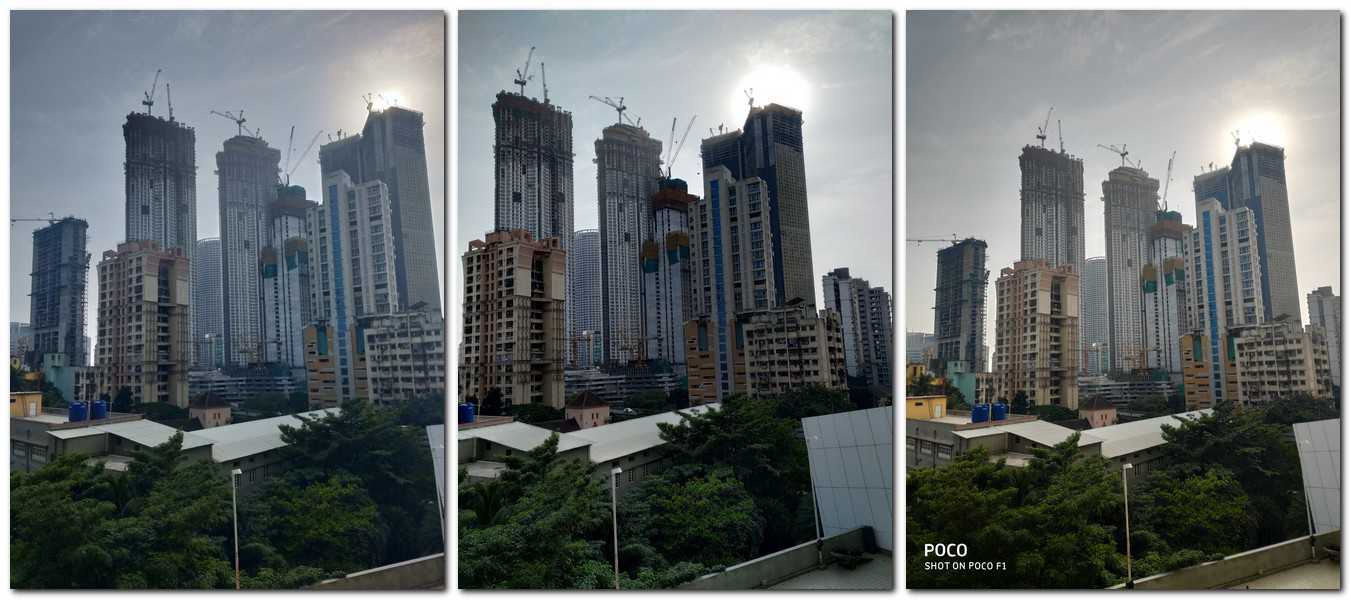 From left to right: Realme 2 Pro, Mi A2, and Poco F1.[/caption] [caption id=“attachment_5354781” align=“alignnone” width=“1351”]
From left to right: Realme 2 Pro, Mi A2, and Poco F1.[/caption] [caption id=“attachment_5354781” align=“alignnone” width=“1351”]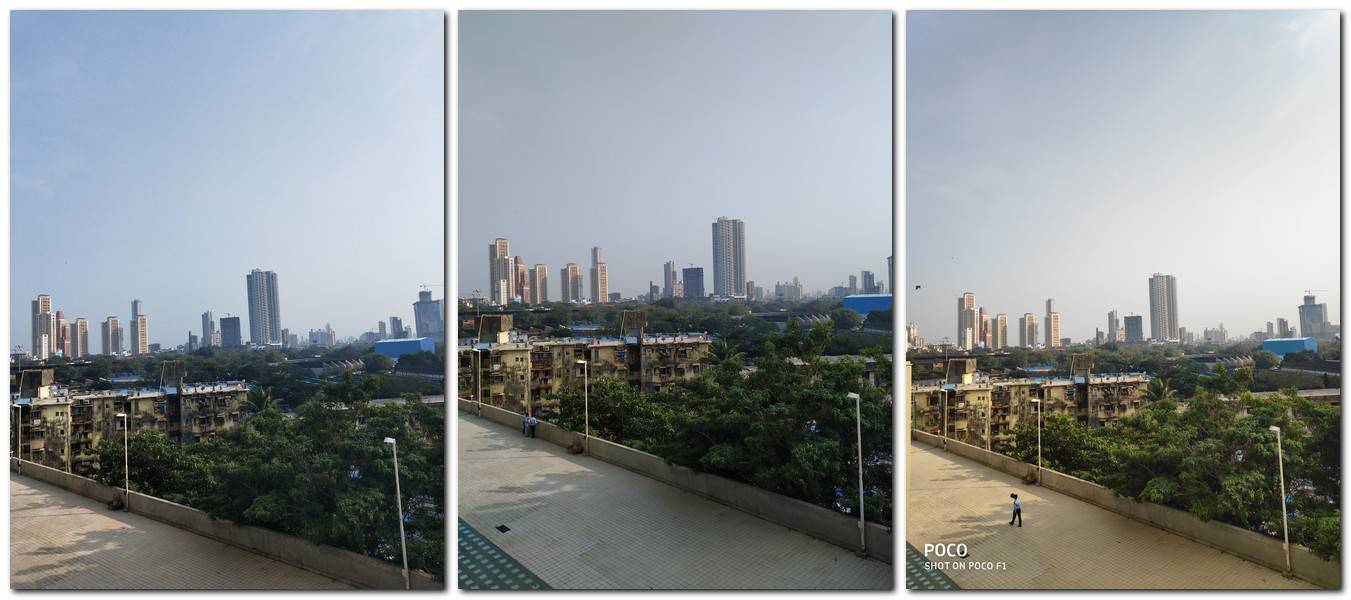 From left to right: Realme 2 Pro, Mi A2, and Poco F1.[/caption] [caption id=“attachment_5354801” align=“alignnone” width=“1349”]
From left to right: Realme 2 Pro, Mi A2, and Poco F1.[/caption] [caption id=“attachment_5354801” align=“alignnone” width=“1349”]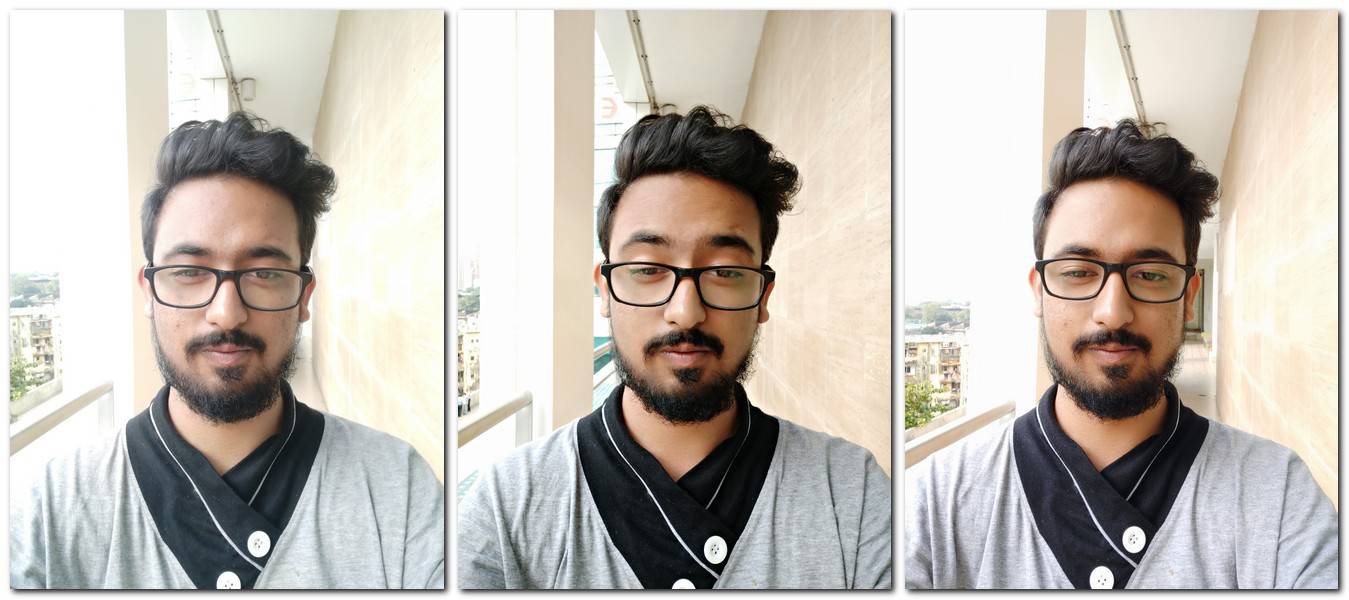 From left to right: Realme 2 Pro, Mi A2, and Poco F1.[/caption] Videos shot on the phone are decent. There is no image stabilisation of any kind, optical or electronic, while the Mi A2 and Poco F1 both have EIS. That being said, the video looked a bit shaky on the Realme but it does the job satisfactorily enough. Coming now to the selfie part, I have to say that my expectations were not super high and I was quite right. The beauty mode is something that is constantly active in some form or the other even when I turned it off. Selfies from the front camera were unnecessarily overexposed as can be seen above. Although the phone does a good overall job of removing my blemishes on my skin, I think that Realme should’ve focused more on capturing details rather than oversharpening. For high-resolution images taken from the Realme Pro 2, click the link below
From left to right: Realme 2 Pro, Mi A2, and Poco F1.[/caption] Videos shot on the phone are decent. There is no image stabilisation of any kind, optical or electronic, while the Mi A2 and Poco F1 both have EIS. That being said, the video looked a bit shaky on the Realme but it does the job satisfactorily enough. Coming now to the selfie part, I have to say that my expectations were not super high and I was quite right. The beauty mode is something that is constantly active in some form or the other even when I turned it off. Selfies from the front camera were unnecessarily overexposed as can be seen above. Although the phone does a good overall job of removing my blemishes on my skin, I think that Realme should’ve focused more on capturing details rather than oversharpening. For high-resolution images taken from the Realme Pro 2, click the link below Bottom line: This is not a phone with the best of cameras. Sure, it will take good photos for the average user, but if the details matter to you I believe that the Mi A2 would be perfect. Even better would be the Redmi Note 5 Pro which, as
**per our review** , has an even better camera. Battery: 7.5/10 One thing that bothered me was why would the Realme 2 Pro downgrade its battery (3,500 mAh) from the Realme 2 (4,230 mAh). I believed the better processor on the Pro would offset the smaller battery capacity and give as good a battery life as the Realme 2. I was not entirely correct as the battery life does take a hit on the Realme 2 Pro, considering the device has a relatively powerful processor. I went through a whole day using my Telegram, WhatsApp, Slack, Facebook, and Instagram account. I also played a few rounds of PUBG and watched quite a lot of videos on mobile data. Even after all that I still had around 25 percent battery left at the end of the day, which is pretty good in my opinion. Our standard PC Mark test didn’t work on the device and neither does the OS provide any battery graphs in its battery menu. Verdict and Price in India You should buy the Realme 2 Pro for
- Big, almost bezel-less display
- Good battery life
- Snappy performance
You should not buy the Realme 2 Pro because of
- Poor user interface
- Average camera
- Average gaming
The major point I am trying to make is that it really makes no sense in buying the Rs 17,990 version of the Realme 2 Pro. Spending just a couple of thousand more can get you the Poco F1 which is the best performing phone in the mid-range category. The Rs 13,990 version of the phone seems to be a more enticing deal according to me, as it offers the same Snapdragon 660 chipset while cutting down the RAM to 4 GB. For most of your day-to-day usage, 4 GB of RAM will be good enough. [caption id=“attachment_5355141” align=“alignnone” width=“1280”] Buy the cheaper variant of the Realme 2 Pro instead of this Rs 17,990 version. Image: tech2/Shomik Sen[/caption] If it is good, clean software experience you are looking for along with a great camera then you don’t need to look any further
**than the Mi A2** . Realme 2 Pro goes on sale on 11 October for a price starting at Rs 13,990 exclusively on Flipkart.


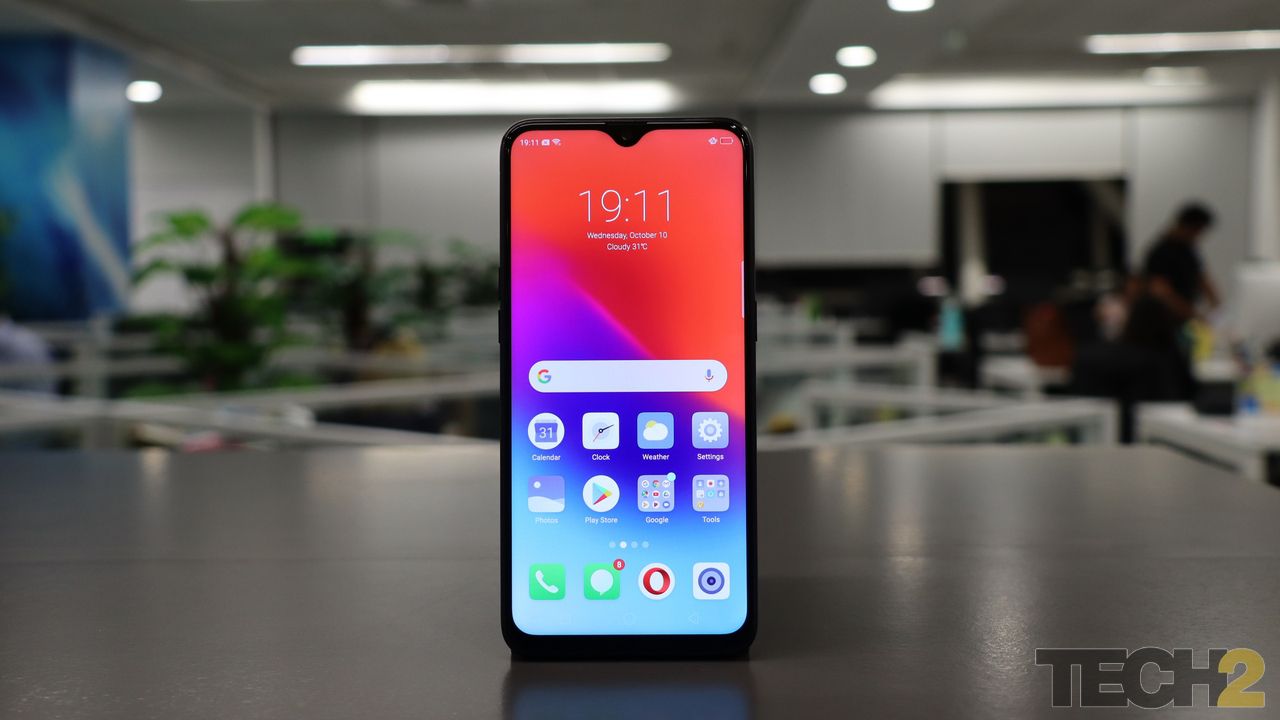)
)
)
)
)
)
)
)
)



